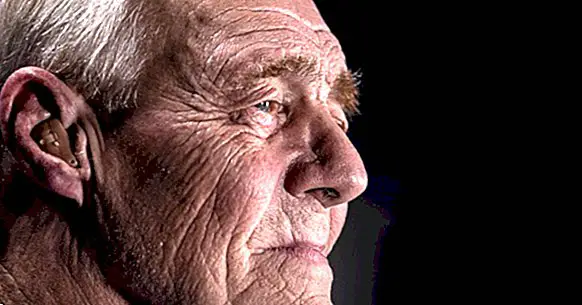Types of dementias: the 8 forms of cognition loss
The scientific advances in the field of medicine have allowed throughout history that little by little we have been able to overcome and survive a large number of diseases of different types, improving the quality of life and increasing our life expectancy .
However, there are still diseases there are a lot of diseases and disorders that continue to pose a serious problem for our health and survival. Some of the major diseases to be abated today are cancer, AIDS or the type of disorders to which this article is dedicated: the different types of dementias.
The concept of dementia
With the progressive increase in life expectancy and the drop in the birth rate of our society, the average age of the population is gradually increasing. So, little by little, there is an increasing increase in the aging of the population, and therefore some of the disorders linked to or aggravated by age . Among them are dementias.
Dementia is understood as the type of neurodegenerative disorder of organic origin which is characterized by a progressive loss of one or more mental faculties, which usually includes memory along with other capabilities, which interfere with the correct functioning of the person and cause discomfort and / or loss of autonomy. The detected deficiencies suppose a worsening with respect to the previous action and they do not occur only in a situation of alteration of the conscience.
Is about a type of chronic, progressive and irreversible disorder (although in some cases the degenerative process can be stopped and there may even be a complete or partial recovery, as in those caused by hydrocephalus, poisonings or infections), produced by alterations in the body linked to a disease, substance use or deterioration and / or degenerations of the usual brain processes. In addition, their effects may vary according to the types of memory they affect the most.
- Related article: "Mild Cognitive Impairment (DCL)"
Classes according to the location of the injuries
In dementias the nervous system is deteriorated little by little, deteriorating the different structures and nervous beams and losing different functionalities as the disease progresses. However, the specific effects and deficits that each type of dementia will cause depend on the structures affected and the causes that cause such degeneration.
Based on the location of the damage we can find different types of dementia .
1. Cortical dementias
Cortical dementias are those in which the main lesions are localized to the cerebral cortex. Due to the implication of this part of the brain in the processing of information and deep work at the level of information processing, this affectation produces the progressive loss of superior mental functions such as reasoning, or abstraction, as well as the association between stimuli and concepts or memory.
In this type of dementias usually appears in the first place an affectation of the memory both anterograde and retrograde (in the latter case temporarily graduated) followed by what is known as afaso-apraxo-agnóstico syndrome, in which problems appear in speech, sequencing of movements and recognition of stimuli.
Some of the most well-known cortical dementias are Alzeheimer in its initial stages, frontotemporal dementias, Pick's disease or dementia with Lewy bodies.
2. Subcortical dementias
Subcortical dementias are those in which the involvement occurs especially in the subcortical structures, such as the basal ganglia, the thalamus or the brainstem. Some of the most recognizable symptoms are those linked to a high level of motor slowdown, the presence of passivity, lack of motivation, withdrawal, apathy, affective flattening and alterations of the frontal lobes that cause the loss of executive functions.
Although there is also memory loss, in subcortical dementias this is equally serious regardless of the moment you are asked to remember, generally having a poor retrograde memory. The dementia derived from Parkinson's, HIV and Huntington's Korea are some of the best known.
3. Axial dementias
This type of dementia mainly affects the limbic system, its main symptoms being Impairment of learning capacity and working memory . Although it is not usually considered a dementia, Korsakoff syndrome is the best known case.
4. Global dementias
These are dementias in which features associated with lesions appear in both cortical and subcortical areas. Although at the origin the lesions can be located in certain parts of the brain, in most of the dementias the degeneration of the nervous structures ends up affecting the entire brain over time , like Alzheimer's.
Main types of dementias
Regardless of its neuroanatomical location, Some of the main types of dementias are the following .
1. Alzheimer's disease
The most well-known and usual dementia, Alzheimer's disease, is a dementia of cortical origin (although it ends up being cortico-subcortical) of insidious origin and slow progress that begins in the parieto-temporal area of the brain, with a progressive advance towards the frontal and the rest of the brain.
The cause of this disease is still unknown today, although they are seen in the brains of those who suffer a high number of neurofibrillary tangles and beta-amyloid plaques .
There are usually three different phases. The first symptoms are usually the deterioration of recent memory, together with the presence of anterograde amnesia. A slight anomie and an impoverished language appear. Other alterations also appear such as the loss of olfactory capacity, loss of interest and motivation, rigid behavior and irritability. In this phase there is often emotional suffering and even depression, since there is usually awareness of illness. Still, it is capable of being autonomous.
In a second phase, major difficulties begin to appear, since it is at this time that the aphaso-apraxo-agnosic syndrome usually appears. Cognitive capacities deteriorate to a great extent, appearing retrograde amnesia and a high level of disorientation. In this state the individual is no longer able to lead an autonomous life, requiring constant supervision .
In the last phase, the subject is already able to recognize neither the significant persons nor himself, losing the language until reaching the silence and the basic skills of daily life. Over time it also loses motor skills, until it reaches permanent bedding .
2. Frontotemporal
Frontotemporal dementias are a subgroup of dementias also called taupathies (since alterations in the tau protein occur) that are characterized because the main affectation occurs in the frontal and temporal lobes, resulting in great alterations of personality and in the area of language .
There are three variants, the frontal one characterized by personality and behavioral changes, the semantic dementia in which the loss of meaning of the words stands out without changing the other aspects of the language and the progressive primary aphasia in which difficulties appear in all areas. of language.
3. Dementia with Lewy Bodies
The most visible symptoms of this cortical dementia are serious attention problems and executive functions, presenting the aphaso-apraxo-agnosic syndrome, parkinsonian-type motor symptoms and hallucinations and delusions. Of progressive start and fast course, it is very frequent that there are intense psychotic symptoms and disorientation , as well as sudden losses of consciousness.
The structures known as Lewy bodies tend to appear in most of the cerebral cortex, along with a deficit of dopamine.
4. Due to prion disease or Creutzfeldt-Jakob disease
It is a dementia caused by the transmission of prions, proteins without nucleic acid that infect the nervous system. They cause sudden and rapid dementia, with motor problems such as tremors and spasms and an abnormal functioning of the neurons.
5. Due to Parkinson's disease
Parkinson's disease is a neurological disorder in which the subcortical structures, especially the basal ganglia and the substantia nigra (and especially the nigrostriatal pathway) progressively degenerate. In these areas, a high prevalence of Lewy bodies can be observed.
This degeneration is caused by a deficit in the functioning of dopamine, with the most characteristic symptoms the appearance of parkinsonian tremors that are produced especially in review status. There are also difficulties in walking, motor slowing, stooped posture, poor movements and facial inexpressiveness.
Dementia associated with this disease, subcortical type, does not appear in all cases, although as the number of years increases from the onset of symptoms is more likely to occur. The typical symptoms of this dementia are the slowing both physically and mentally, along with high passivity .
6. By Huntington's Korea
Huntington's disease is a disorder of autosomal dominant genetic origin of complete penetrance that affects in a particularly virulent way the neurons governed by the neurotransmitter GABA and the acetylcholine of the basal ganglia.
Of slow and progressive onset, in this neurodegenerative disease appear constant uncontrolled movements, in the form of twists and twists of the body parts that remember or a dance.
The incocial process, subcortical type, usually starts with changes in behavior and personality along with a marked alteration of memory , also appearing over time an affectation in the frontal lobe that leads to a progressive loss of executive functions such as planning and sequencing.
7. Dementia due to HIV
HIV infection, after several years of evolution, may end up causing in some cases the degeneration of multiple brain structures and pathways, causing a specific type of dementia known as a dementia complex associated with HIV.
This type of dementia classified as subcortical is characterized by the presence of slowing down, reading problems, loss of spontaneity and hallucinations, decreased movement tracking and deterioration of movement in general. It usually advances quickly to a serious dementia which leads to the death of the patient.
8. Vascular or multi-infarct dementia
This type of dementia is caused by the presence of strokes, either in the form of hemorrhage or stroke, that affect one or several parts of the brain. The effects can vary enormously according to the affected area, producing a deterioration in some functions such as memory or language.
It is a type of dementia that, unlike most, it starts suddenly and abruptly, noticing as a general rule the patient's change of state and physical or mental abilities . It is frequent that the deterioration produced occurs in a staggered manner, and there are also some periods of partial recovery.
Bibliographic references:
- American Psychiatric Association. (2013). Diagnostic and Statistical Manual of Mental Disorders. Fifth edition. DSM-V. Masson, Barcelona.
- Santos, J.L. ; García, L.I. ; Calderón, M.A. ; Sanz, L.J .; de los Ríos, P .; Left, S .; Román, P .; Hernangómez, L .; Navas, E .; Thief, A and Álvarez-Cienfuegos, L. (2012). Clinical psychology. CEDE Preparation Manual PIR, 02. CEDE. Madrid.



















